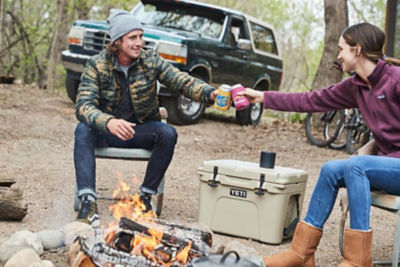How to Pack for a Spring, Summer or Fall Hike
Enjoy the outdoors for as long as you can before winter's freeze ushers you back indoors. Stay geared up from spring through fall with these hiking Pro Tips.

When the freeze of winter loosens its grip and makes way for warmer weather, you’ll want to be ready to jump right back into the outdoor adventures you’ve longed for since the first frost. In order to make the most of your time on the trails before temperatures dip back down, you’ll want your gear to be set up to conquer the conditions. In order to do this, you’ll want to curate your hiking apparel and pack with a three-season mindset.
The term “three-season” is used to describe hiking and camping gear suitable for most settings other than severe winter weather. Typically, the lowest temperature that three-season gear should be used is about 20 degrees, or simply any temperature that can fall below freezing without being unbearably cold.
It might be perceived as a challenge to find equipment that can efficiently perform in the rainy mornings of spring, hot days of summer and brisk evenings of fall. By understanding your approach, however, and by knowing which items are necessities, you’ll be commanding trails and paths from the last snowflake to the first.
LEARN TO LOVE LAYERS
When you’re searching for apparel that can perform in just about any condition, the best way to combat the elements is by layering. For baselayers, look for clothing that features breathable, moisture-wicking capabilities. Avoid cotton at all costs, because while it might be comfortable, it can quickly become a nuisance on the trail. Once cotton becomes wet, it stays that way, which could lead to possible chafing, blisters and even potentially hypothermia if temperatures drop. Remember, cotton is rotten.
In order to decide which clothes to wear and which to pack, a good rule of thumb is to dress for the forecast and pack for change. Pay attention to weather predictions for your day’s hike and dress in lightweight, breathable clothing with proficient moisture-wicking and thermal capabilities. Pack extra baselayers, along with a change of hiking socks, and other outerwear like rain pants and a rain jacket, Rainy conditions can occur no matter what season you’re in, so having that security in your pack at all times is a good idea. For more information on finding the right raincoat for your needs, check out this Pro Tip.
Don’t forget to consider your footwear, too. To tackle the imminent mud, sweat, and terrain of three-season hiking, look for waterproof, comfortable hiking boots or shoes. Some early springtime hikes could even include some snow as the weather continues to change, so opt for footwear with a rugged tread built to perform on a variety of surfaces. You can also look for waterproof gaiters that can help shield your shins from the conditions and help keep your footwear even more protected from the elements.
ESSENTIALS: NAVIGATION, TOOLS AND EMERGENCY GEAR
No matter the length of your hike, make sure that you’re equipped in case of any potential emergency. Weather can change, trails can turn confusing and injuries can happen. Be sure to pack your gear with essentials to help you stay safe.
When hiking or exploring, it’s always helpful to carry a map and compass. Even if you plan on carrying a GPS unit, a map and compass could help guide you in case batteries die and you’re left to more utilitarian navigation. Check to make sure your maps are up to date and that you brush up on how to properly use a compass prior to venturing out. Remember, a tool is only useful if you know how to use it.
Speaking of tools, a pocket knife or multi-tool should also be in your pack. These can be useful for many activities like fixing gear, cutting branches, cooking and more. You should also consider carrying a fire starter of some sort (waterproof matches, fire stick, etc.), a headlamp and additional survival rope or carabiners.
Trekking poles can be another great asset. These pieces can help take some strain off your body during hikes and make for a more comfortable adventure. Consider trekking poles if your intended trail has a lot of ascents and descents, too, as they are created to help absorb some of the impact while walking and add stability to your profile.
You should also never hike without a well-stocked first-aid kit. Be sure that you have plenty of adhesive bandages and sterile pads. It’s also smart to carry lip balm, insect repellent, anti-itch cream or poison ivy treatment, water purifying agents and sunscreen in your first-aid kit for backup. Throughout the warmer months, sun exposure can vary and you may come across a variety of plants and insects, so it’s best to cover all your bases and stay prepared. Be sure that you’re equipped with the right gear so you can be as comfortable on the trails as a bug on a leaf.
PRO TIP: Throw a safety whistle into your first-aid kit in case you become injured and need to alert others for help. Whistles are small and easily packable, but they could be your greatest lifeline if trouble arises.
Discover even more tips on how to pack your pack for a hike.
STAY FUELED WITH DRINKS AND SNACKS
When you’re out on the trails, regardless of the season, be sure to pack a full hard shell water bottle to help stay quenched on your adventures. Pack as much water as you comfortably can. Having too much water is always better than too little. You can also utilize a hydration pack setup if your daypack supports it.
You should also remember to pack a snack or two for quick refueling sessions. Be sure to keep your treats within reach, either in a side pocket, hip pocket or toward the top of your pack. If you need a bite, you don’t want to be digging through your entire pack for one granola bar.
ADDITIONAL GEAR FOR SPRING
While the gear listed above can definitely get you through most excursions between spring and fall, there are some additional items that you may want to consider particularly for the spring months. Mid-weight layers and additional cold-weather gear like hats and gloves can help keep you warm on your hike while the landscape continues to thaw.
You might also want to wear waterproof or moisture-wicking pants. Because spring conditions can be wetter than most with overcast rain or thawing environments, you don’t want to end up soaked to your skin and risk chilling off.
Spring hikes can also include some snow travel, depending on the region. If you know you’ll be getting into areas that might still be blanketed with snow, consider packing a travel snow shovel or ice axe to clear trails or make pathways. Be sure that your hiking footwear has an aggressive tread and consider packing crampons or traction cleats for better footing in less-than-suitable situations.
PRO TIP: As plants and insects begin to flourish in spring, so do invasive species. Non-native plants like English Ivy and Purple Loosestrife can hitch a ride on your gear and boots into newfound areas, which could cause problems in their new environment. In order to limit the spread of non-native plants and insects, be sure to stay on designated trails during your trek and wipe your gear down before and after your journey.
ADDITIONAL GEAR FOR SUMMER
The dog days of summer are a great time to hit the hills and adventure out into the wilderness. With heat being the main factor in summer, it is pivotal that you keep yourself hydrated. Make sure that you pack plenty of water and take necessary stops along the way.
You can typically ditch the cold weather gear during your summer hikes and swap in a shady hat and sunglasses. Lightweight layers made from breathable, moisture-wicking materials make a great summer hiking outfit. Zip-away pants are also great for summer treks, as they help keep you protected from insect bites and things like poison ivy, but give you the option of shorts in case the temperature begins to rise.
ADDITIONAL GEAR FOR FALL
Your hiking gear for fall is going to be very similar to your spring equipment. Temperatures will begin to drop again, meaning you should return your mid-weight layers to your hiking pack. Brisk winds can also become more prevalent in autumn, so it might be wise to pack a quality windbreaker or wind-resistant raincoat as well.
You should continue to pack a water bottle for fall hiking, but don’t be afraid to add some variety to your beverages. Pack a thermos and enjoy a warmer drink on the trails, too. This hot treat can be perfect for those later autumn afternoons.
Depending on your region and where you plan on hiking, you should also wear hiking apparel that is bright and highly visible. Fall means the start of a new hunting season for many sportsmen, and you could potentially be sharing the woods with hunters during your hike. In order to remain visible on the trails, look for apparel in fluorescent colors. A fluorescent orange vest and hat combination is a great way to stay in sight.
Lastly, remember that evening hours can become darker in the fall due to the time change. Keep your headlamp ready, along with extra batteries in case you find yourself enjoying nature a little longer than intended.
PRO TIP: Some parks and trails can start to reduce hours or close up for the winter months in the fall. Be sure to check with park authorities on closing times and dates so that your expeditions don’t end before they even begin.
With these hiking tips at your disposal, you can make the most of your time outdoors. While no hike is the same and some conditions might warrant more or less gear, these hiking essentials should give you a solid base to continue your expeditions from thaw to freeze. Follow these hiking tips to stay on the trail and soak in as many experiences as possible before Old Man Winter comes knocking once again.
Are you heading out on a hike with your family? Be sure to check out our tips on how to make hiking more interesting for kids.








